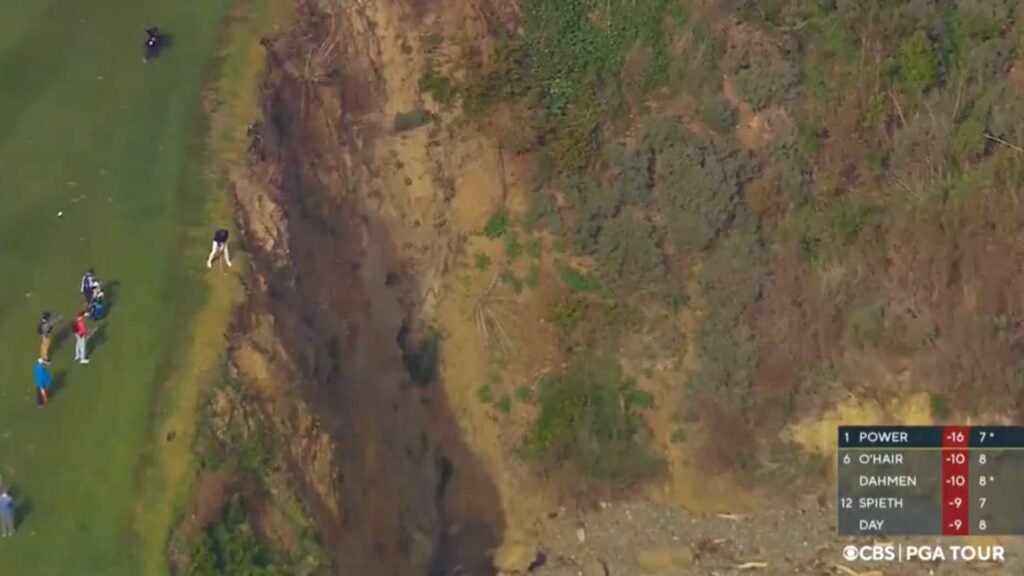Nick Faldo, tongue in cheek, twice asked for help. As Jordan Spieth stood over a shot just inches from the edge of a cliff with a 70-foot drop on the 8th hole at Pebble Beach, the six-time major champion called out to Colt Knost, a fellow analyst on CBS’ broadcast. And Michael Greller, Spieth’s caddie:
Somebody give the man a hand!
“Colt’s going to have to hang onto him,” Faldo said.
And later:
“So Greller takes his belt off and ties it to Jordan’s belt. Is that allowed? Is that artificial aid if someone is hanging on to you?” Faldo said.
“I think so,” fellow analyst Ian Baker-Finch said.
It was. Unfortunately for Spieth, he was on his own during Saturday’s third round of the Pebble Beach Pro-Am, according to the rules of golf.
No, Knost, Greller nor anyone could grab Spieth as he took his stance, with his right foot about a yard from the cliff, and his left sloping into it. Rule 10.2b (5) states: “A player must not make a stroke: While getting physical help from his or her caddie or any other person,” and the penalty would be two strokes (plus the stroke itself).
As it turned out, Spieth hit, finished with a bit of baseball-like uppercut, ran eight steps back, his ball landed just over the green, and he made a par. Afterward, he said that he went back and forth with Greller over the shot. Also in play was a drop, with one penalty stroke attached, as the ball had crossed over and into a red-stake penalty area. (Rule 17.1d explains the relief options.)
“He said, I just don’t, I just don’t see the point. I don’t think it’s worth it. I just don’t see the point,” Spieth said of Greller. “Stuff like that, I think.
“And I was — he said that next, if that were to happen again, he’ll walk up, grab my ball and throw it in the water, so that I can’t hit it. He said, I should have done that. He was like, I just didn’t know what to do myself.
“And I kept on, I was adamantly telling him, like pretty aggressively, like, please don’t get, go across that red line. To him. And that put him in a tough spot. But if he went across that red line, he wouldn’t have let me hit it, I don’t think.”
A few rules issues are in that quote. Of course, Greller and any caddie can advise a player, and that’s covered in Rule 10.3b. But could Greller, or any caddie, “walk up, grab my ball and throw it in the water, so that I can’t hit?”
Like the question of whether a caddie could hold on to a player, the answer is also no. If Greller picked up Spieth’s ball without Spieth giving the OK, in effect would be another part of Rule 10.3b, which states: “A caddie is not allowed to take these actions for the player: Decide to take relief under a Rule (such as treating a ball as unplayable under Rule 19 or taking relief from an abnormal course condition or penalty area under Rule 16.1 or 17); the caddie may advise the player to do so, but the player must decide.” And the penalty would be one stroke, under Rule 9.4. (Rule 14.1 covers who may pick up a ball.)
In short, outside of Greller’s advice, Spieth was on his own.
“It’s so weird because if you can normally see the ball, like I never had a situation where you can see a ball, get a swing on it, but you’re not going to play it,” Spieth said of the shot. “So it was just kind of weird because it was like, well if I can get a swing on it and I can hit it then why would I take a drop? Like just whenever, you’re never over, I guess I saw a 65-foot cliff. So it’s an unusual situation, normally if you’re walking into a hazard, you see a ball, you hit it out.
“Michael hated it. He tried to talk me out of it three times. I don’t blame him, looking back. I’m just glad I made the par to make it worth it, because I don’t think I would have made par with a drop, but if I made bogey, it would have really not been worth it.
“But yeah, I mean it was, I was more like, it was more of a nervous and adrenaline hitting it and then when I got to the green as I was walking there it was more of like an anxiety feeling afterwards, luckily it wasn’t before.”
